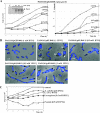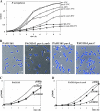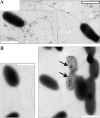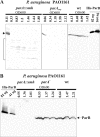Deletion of the parA (soj) homologue in Pseudomonas aeruginosa causes ParB instability and affects growth rate, chromosome segregation, and motility
- PMID: 17545287
- PMCID: PMC1951838
- DOI: 10.1128/JB.00371-07
Deletion of the parA (soj) homologue in Pseudomonas aeruginosa causes ParB instability and affects growth rate, chromosome segregation, and motility
Abstract
The parA and parB genes of Pseudomonas aeruginosa are located approximately 8 kb anticlockwise from oriC. ParA is a cytosolic protein present at a level of around 600 molecules per cell in exponential phase, but the level drops about fivefold in stationary phase. Overproduction of full-length ParA or the N-terminal 85 amino acids severely inhibits growth of P. aeruginosa and P. putida. Both inactivation of parA and overexpression of parA in trans in P. aeruginosa also lead to accumulation of anucleate cells and changes in motility. Inactivation of parA also increases the turnover rate (degradation) of ParB. This may provide a mechanism for controlling the level of ParB in response to the growth rate and expression of the parAB operon.
Figures








References
-
- Adachi, S., K. Hori, and S. Hiraga. 2006. Subcellular positioning of F plasmid mediated by dynamic localization of SopA and SopB. J. Mol. Biol. 356:850-863. - PubMed
-
- Autret, S., and J. Errington. 2003. A role for division-site-selection protein MinD in regulation of internucleoid jumping of Soj (ParA) protein in Bacillus subtilis. Mol. Microbiol. 47:159-169. - PubMed
-
- Bartosik, A. A., and G. Jagura-Burdzy. 2005. Bacterial chromosome segregation. Acta Biochim. Pol. 52:1-34. - PubMed
Publication types
MeSH terms
Substances
Grants and funding
LinkOut - more resources
Full Text Sources
Molecular Biology Databases

